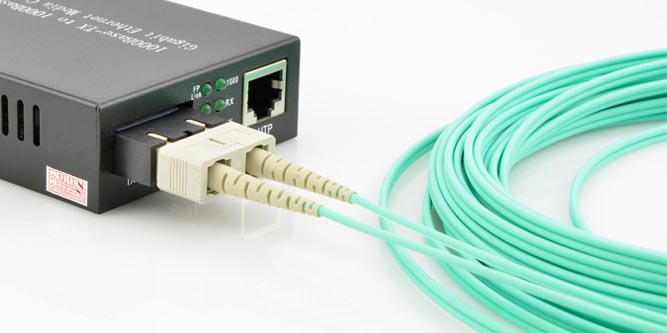Fiber optic cables are extremely reliable and provide faster data transfer speeds than traditional copper cables. However, many businesses find themselves in a situation where they need to convert fiber optic signals to Ethernet in order to use their existing infrastructure. This post will provide an overview of the basics of converting fiber to Ethernet in your network, as well as the advantages and disadvantages associated with this solution. We’ll also explain what type of equipment is needed to make the conversion, so you can evaluate if it’s the right choice for your business needs. So let’s dive in!
How do you convert fiber optic cable to Ethernet?
When it comes to setting up a network, there are a few different ways that you can go about converting fiber optic cable to Ethernet. Depending on your needs, you may want to consider using an Ethernet switch, a media converter, or a direct connection.
Ethernet Switch: An Ethernet switch is a device that allows you to connect multiple devices to one another using Ethernet cables. This is a great option if you have multiple devices that you want to connect to the internet or if you want to create a local area network (LAN).
Media Converter: A fiber media converter is a device that converts the signal from one type of cable to another. This is a great option if you only need to connect one device to the internet or if you have a mixture of different types of cables in your network.
Direct Connection: If you only need to connect one device to the internet, you can do so by directly connecting the fiber optic cable to the Ethernet port on your device. This is the simplest way to convert fiber optic cable to Ethernet and requires no additional hardware.
What are the challenges of converting fiber optic cable to Ethernet?
There are a few challenges that can arise when converting fiber optic cable to Ethernet. One is that the two technologies use different types of connectors. Ethernet uses RJ-45 connectors, while fiber optic uses ST or SC connectors. This can make it difficult to connect the two types of cables together without an adapter.
Another challenge is that fiber optic cable typically has a much higher bandwidth than Ethernet cable. This means that if you’re not careful, you can easily overload your network by mistake. You need to be sure to configure your network properly so that it can handle the increased traffic.
Finally, fiber optic cable is typically more expensive than Ethernet cable. This means that you’ll need to carefully consider whether the benefits of using fiber optic outweigh the costs before you make the switch.
How do you troubleshoot a fiber optic to Ethernet conversion?
One of the great advantages of fiber optic cabling is that it can be easily converted to Ethernet. This means that if you have a fiber optic network and you want to connect it to an Ethernet network, you can do so without having to replace all of your cabling. However, there are a few things you need to know in order to troubleshoot a fiber optic to Ethernet conversion.
The first thing you need to check is the connection between the fiber optic cable and the Ethernet port. If the connection is loose, it could be causing problems with the signal. Make sure that the connection is secure and tight.
If the connection is good, then the next thing you need to check is the settings on the Ethernet port. Make sure that the port is set to 100BaseT or higher. If it’s not, then you won’t be able to get a good signal from the fiber optic cable.
Finally, if you’re still having problems, then you may need to replace the Ethernet port. Sometimes, ports can go bad and they need to be replaced. If you’re replacing the port, make sure that you get one that’s compatible with your system.
Conclusion
Converting fiber optic to Ethernet in your network is a great way to improve the speed, performance and reliability of your system. It’s important to understand the basics before you start making any changes, so that you can make sure everything goes smoothly. With a little bit of research, some quality tools and materials, and proper preparation, anyone can successfully convert their network from fiber optic to Ethernet. Good luck!
